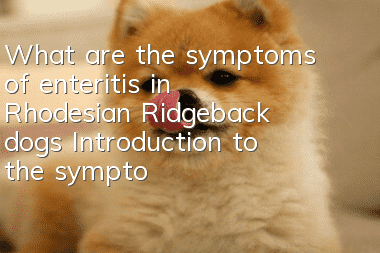What are the symptoms of enteritis in Rhodesian Ridgeback dogs? Introduction to the symptoms of enteritis in lion hounds

What are the symptoms of Rhodesian Ridgeback canine enteritis? Dog enteritis refers to acute or chronic inflammation of the intestinal mucosa. Enteritis can occur as a separate disease affecting only the small intestine, but more commonly it is widespread inflammation of the stomach, small intestine, and colon.
1. Causes of canine enteritis:
The cause of enteritis is roughly the same as the cause of gastritis in dogs:
1. Ingesting rotten or contaminated food, or accidentally ingesting poisonous bait, irritating drugs, foreign objects, etc.
2. Secondary to certain infectious diseases such as canine distemper, parvovirus, coronavirus disease, parasitic diseases (such as tapeworms, roundworms, hookworms, whipworms, and trichomonas), etc. In addition, pathogenic bacteria can also cause enteritis. For example: Escherichia coli, salmonella, Proteus, etc. can cause enteritis.
3. If your dog is always under a high degree of nervousness, it can easily lead to enteritis.
2. Clinical symptoms of canine enteritis:
1. Diarrhea is the main symptom of canine enteritis, which can be seen at the beginning of the disease. The feces is liquid and has a foul odor, and in the later stages it is often mixed with mucus, blood, foam, etc.
2. During auscultation of the abdomen, one can hear increased bowel movements or thunderous sounds, the abdomen is tense, and the waist and back are curved.
3. When inflammation spreads to the front of the duodenum or stomach, sick dogs are often accompanied by vomiting.
4. When a sick dog shows symptoms of tenesmus, it means that the inflammation has spread to the colon. When bleeding occurs in the small intestine, the feces will be dark green or black.
5. Sick dogs have mild or moderate fever. If infected with bacteria, the body temperature can be as high as 39-39.5 degrees Celsius.
6. As the disease progresses, sick dogs may show symptoms of dehydration and acidosis. At this time, the sick dog often lies on the ground, the skin lacks elasticity, the eyeballs are sunken, the conjunctiva is cyanotic, the dog is highly dehydrated, the urine output is reduced, and in severe cases, it may cause coma or death from autotoxicity.
3. Prevention and treatment measures for canine enteritis:
1. First, fast the dog for 1-2 days. In order to prevent dehydration and electrolyte imbalance, the sick dog should be rehydrated, either by intravenous infusion of Ringer's solution or lactic acid compound sodium chloride solution.
2. Clean the gastrointestinal tract: laxatives (such as sodium sulfate, artificial salt) should be used orally in appropriate amounts.
3. Anti-inflammatory and antidiarrheal: use 0.1~0.5g of berberine, taken orally 3 times a day. Among the antibiotics, chlortetracycline, oxytetracycline or chloramphenicol can be used. For non-bacterial enteritis, when the accumulated feces has been basically eliminated and the feces has no sour smell, but still has severe diarrhea, astringent drugs should be given to stop diarrhea, such as activated charcoal.
4. If there are bleeding symptoms, hemostatic measures should be taken. Hemostatic sensitivity can be injected intramuscularly.
5. Antiemetic, metoclopramide, 1~2 mg/kg body weight, intramuscular injection, 2 times/day.
6. In case of parasitic enteritis, in addition to the above therapies, anthelmintic drugs should be given. See specifically ascariasis.
- Three things to note when bathing your dog
- What's wrong with the dog being lethargic and lack of energy?
- How to read the signs of illness in your dog?
- What does it mean when a dog whines?
- Pimples on dogs
- What's going on when a dog is vomiting and shivering?
- What are the symptoms of toxoplasmosis in dogs? Take a look!
- Why can't the dog bark?
- How to teach a dog to go to the toilet, dog toilet training methods!
- What should I do if my dog doesn’t want to take a bath?



